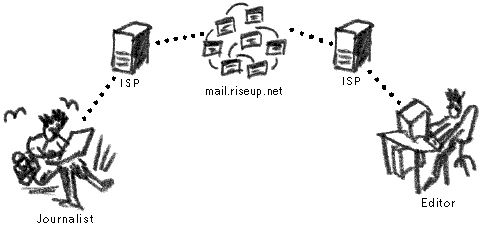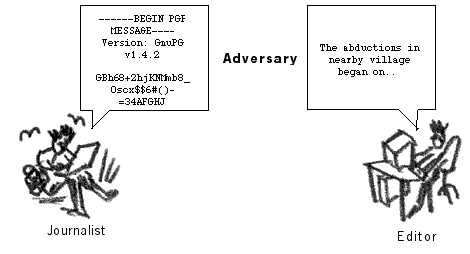3.4 Case Study 4
Secure Email and Blogging
Outline
An independent journalist reports on human rights violations
in her country. She has a laptop on which she works from
home and which she often takes with her on assignments. She
writes mainly for foreign publications and uses a pseudonym,
for it is dangerous to publish such information in her
country, where the media are severely censored and the
government is known to have sufficient expertise in tracking
online journalists. She also runs a blog where all
her articles are published, too.
She is finding it increasingly difficult to keep working.
Her articles sent by email do not arrive at their
destination, access to her blog site has been
blocked and she is afraid of endangering the people whom
she interviews and mentions in her reports. She fears that
her email is being monitored. On one occasion, an editor
wrote to her surprised by the content of her recent
article. On re-reading it, she realises that the article
has been altered by someone on the way from her email box
to the newspaper.
Threats
Before deciding what actions to take, she lists all the
current threats she is facing:
- cannot send articles by email
- cannot access her blog and update it
- her assumed identity could be compromised
- articles, stored on her laptop, are accessible to
outsiders
- viruses or hackers could damage the articles on her
laptop
Solutions
Secure email
As the first priority, she decides to secure her email box,
so that her mes- sages could not be read or altered by an
outsider. She writes to security@ngoinabox.org and asks for
the access codes needed to register a new email account with
RiseUp. This is a webmail email account that can only be
accessed when she is on the Internet. The webmail operates
over SSL and is therefore encrypted between her
computer and the webmail server. She asks all her
correspondents (recipients) to register a free account with
https://mail.riseup.net, too, so that her articles could
reach them only via encrypted Internet tunnels. She decides
to trust the people running RiseUp not to compromise or
access her email.
This appears a simple and effective method for dealing the
journalists' concerns. As long as the address bar in the
Internet browser through which she accesses her email
account begins with 'https:', she knows that her
communications are secure.

Secure communications over SSL
Riseup.net email accounts
As a further precaution, she writes to RiseUp and asks
them to send the fingerprint of their SSL
certificate. They forward her to a page on their website
where this fingerprint is shown. The precaution she is
taking here is against a Man-in-the-Middle attack, whereby
the adversary intercepts the communication line to
https://mail.riseup.net and attempts to fool the user into
thinking they have arrived at the intended website. An SSL
certificate is presented and, once the user accepts it,
the connection is re-directed to the adversary's website.
However, an inspection of the SSL certificate will
show whether or not it is different from the original.110
Securing information
Even though she has managed to secure her email box, she
would still like to make the articles she sends unreadable
to anyone but the designated recipi- ent. This is done in
case she loses her email password or it gets compro-
mised. It is also a good precaution against
Man-in-the-Middle attacks. She installs the Thunderbird
email program and sets it up to read her RiseUp account.
She adds the Enigmail extension to Thunderbird and follows
instruc- tion in the Digital Security Toolkit to create a
keypair that she will use to encrypt her articles to the
public key of the editor111. All parties that
wish to commu- nicate securely with each other using the
public key encryption system, will need to install
relevant software and swap their public keys with each
other112.

Using encryption to secure sent
messages
Sometimes, the use of encryption may alert the
monitoring body. She does not know whether encryption
is legal in her country and whether using it will just
attract a lot more unwanted attention to her. She decides
to employ an alternative method that will not immediately
appear cryptic and hence suspicious. By using a
steganography program, she can embed her article in a
photo and upload it to an inconspicuous website. As long
as there is a prior arrangement, whereby the editors know
where and when to look for this picture/article, this
method can bypass many surveillance systems. It should be
implemented by maintaining a regular stream of similar
activity (uploading photos to the Internet) and should not
appear irregular in her normal pattern of activity.113

Using steganography to hide the
presence of a message in your communications
Anonymous email
Another way of countering email blocking and censorship is
to use an array of popular free webmail services. Yahoo,
Hotmail, Gmail and others have millions of registered
users. It is possible to create a completely new account
every time you wish to send an email. The registration
details can be random and, if sent from a public space
(e.g. an Internet café), the email would be very difficult
to track.
It is likely that secure email services (like RiseUp) may
already be blocked or will become blocked after frequent
use. Only a handful of countries block access to large
free email systems, like Yahoo. However, these global
providers have in the past cooperated with some
governments (e.g. the Chinese government) in giving the
latter access to their users' email accounts. Should our
journalist decide to use a large webmail provider, her
usage must be limited to accessing it from an Internet
café or other public space, where her details are not
recorded and the IP address, from which the email is sent,
cannot be traced back to her. She can also create accounts
using a pseudonym, pre-arranged with her editor.
Circumventing website blocks
To access her blog site, the journalist will require
different methods of cir- cumventing the Internet block
inside her country. The choice of tools will depend on the
government's blocking practice. For example, she could
register to receive news of the latest anonymisers from
Peacefire114 or ask one of her friends living
in a country that does not censor the Internet to set up
Psiphon (see Chapter 2.6 for further explanation) for her
use.

With an anonymous proxy, the
destination website will not know where your computer is
really located
Alternatively, she installs the Tor Browser115 on a USB
memory stick, so that she can operate without any blocking
restrictions whatsoever. Tor will anonymise her website
requests and will penetrate the majority of national
censorship systems.
It is often easier and more practical to ask a friend from
another country to upload your articles onto your blog.
The articles can be transmitted by secure email.
Protecting identity
At present, the journalist does not wish her identity to
be linked with her pseudonym. She is very careful to not
include her real name in the emails and articles she sends
through the Internet. Nor does she use her ISP
email account, as it is linked directly to her. She only
uses her home Internet connection to access a secure
webmail account or does it in conjunction with an
anonymity tool when updating her blog.
Some Internet cafés in her town have begun to record their
users' names and times of access. She avoids these cafés,
as Internet and email activity can traced back to the
computer's IP and eventually to her.
When using a computer in an Internet café, she is very
careful not to allow the browser to remember her passwords
and browsing history. At the beginning of her session, she
spends a couple of minutes configuring the Internet
browser to be more secure and deletes all saved
information from the computer at the end116.
Securing laptop
All articles are written and stored on her laptop. She must
secure herself against their loss, unauthorised entry and
damage from viruses and spyware. She sets a BIOS
password to prevent immediate access to her computer and
installs a free anti-virus, anti-spyware and firewall
program from the Digital Security Toolkit. She updates her
Windows software as soon as known fixes become available.
Since her laptop has a CD writer, she buys some blank disks
and creates a backup of her documents.
Passwords
Her laptop, BIOS, email accounts,
blogs etc. require a password each. These passwords are
essential to her security, as even the most advanced
system is often only as good as the password that protects
it. Since it is impossible to memorise all the passwords,
she uses the KeePass program117 to store them for her. She
has a copy of the program and the password file on her
laptop and USB memory sticks. To increase the security of
her passwords, the KeePass program creates them for her.
To sum up, she has a bag of different tricks and methods
to use at her discretion. At first, they may appear
laborious and time-consuming, but she knows that her
security is paramount. Perhaps a secure laptop and email
address will be enough for her to continue her work. As
some methods of protection become obsolete or unavailable,
she may choose different solutions. The Internet is a vast
landscape, with many possibilities for both surveillance
and anonymity.
|